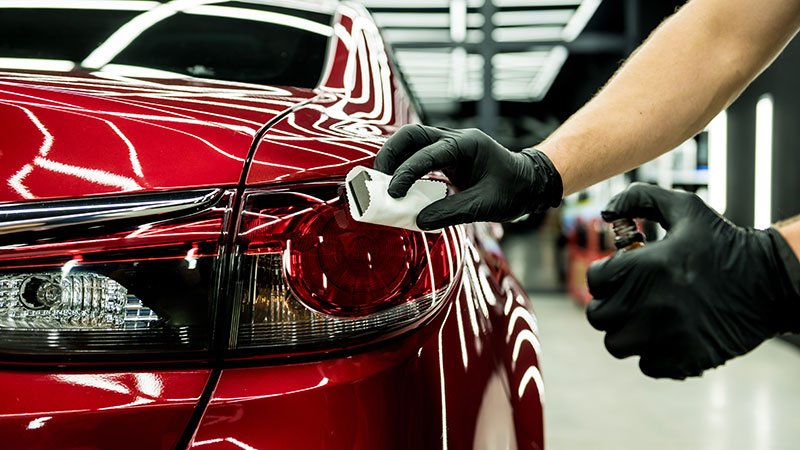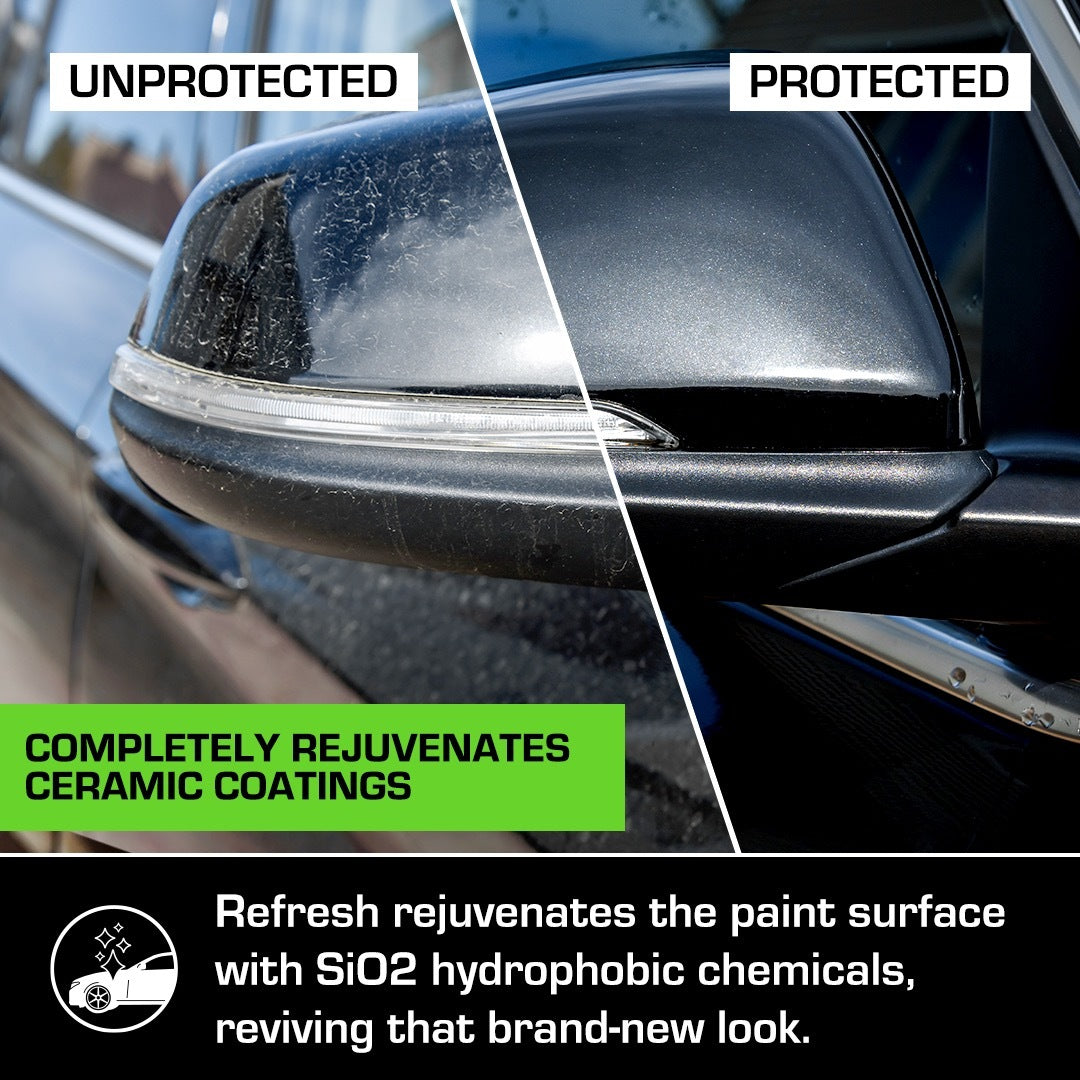Exploring the Science Behind Car Ceramic Coating and Its Safety Qualities
The science of car ceramic coating offers a fascinating research study in advanced automobile security. Composed primarily of silicon dioxide and polymers, these finishings develop a durable bond with lorry paint. This interaction boosts sturdiness versus environmental threats while providing hydrophobic advantages. The details of exactly how these coverings job and their long-lasting advantages continue to be less recognized. Ceramic Coating Newark. Unboxing these information exposes why ceramic coverings are becoming a recommended choice for vehicle care
What Is Ceramic Coating?
Ceramic coating is a fluid polymer that chemically bonds to the surface of a car's paint. This sophisticated safety layer enhances sturdiness and uses premium resistance to ecological elements. Unlike conventional wax or sealants, which offer short-term defense, ceramic coatings create a resilient shield that can hold up against severe conditions such as UV rays, acidic impurities, and severe weather. When applied correctly, the coating creates a hydrophobic surface area, triggering water to grain and slide off, which helps in preserving the lorry's cleanliness. Additionally, it provides boosted gloss and depth to the paint, making the vehicle appear even more refined and lively. The application procedure generally involves thorough surface area preparation, consisting of cleaning and polishing, to ensure peak bonding. Therefore, ceramic layers are coming to be significantly preferred amongst car enthusiasts and those looking for to safeguard their investments, promising to keep the vehicle's visual allure while reducing the regularity of upkeep.
The Make-up of Ceramic Coatings
The complex solution of ceramic layers primarily includes silicon dioxide (SiO2), which is stemmed from all-natural sources like quartz and sand. This essential element gives the structure for the coating's sturdiness and safety top qualities. In enhancement to SiO2, ceramic finishings often include different polymers and additives that enhance bond, flexibility, and resistance to environmental aspects. These substances work synergistically to produce a durable barrier versus pollutants such as dust, chemicals, and UV rays.Furthermore, some solutions incorporate titanium dioxide (TiO2) or various other nanomaterials, which can increase the coating's hydrophobic residential properties, resulting in enhanced water repellency. The exact make-up can vary greatly amongst manufacturers, impacting efficiency and durability. Ultimately, the mix of these aspects finishes in a safety layer that not just enhances the visual appeal of lorries however additionally offers to prolong their lifespan by protecting the surface area from potential damage.
Just How Ceramic Coatings Job
Comprehending just how ceramic finishings function involves discovering their chemical make-up, which contributes to their safety top qualities. The application procedure is necessary for achieving perfect outcomes, while longevity and toughness aspects establish the coating's performance with time. With each other, these aspects highlight the advantages and efficiency of ceramic coatings for car security.
Chemical Structure Explained
While several car proprietors look for long-lasting protection for their lorries, the chemical structure of ceramic coatings plays a vital duty in their efficiency. These layers mostly contain silicon dioxide (SiO2), which is obtained from all-natural minerals. This compound forms a solid bond with the automobile's paint, producing a resilient, safety layer. In addition, many ceramic finishings consist of titanium dioxide (TiO2), improving their hydrophobic properties and resistance to UV rays. The visibility of polysiloxanes can additionally boost flexibility and resilience. Together, these elements add to the coating's capability to ward off water, dust, and impurities, while likewise giving a high-gloss surface. Recognizing this chemical foundation aids car owners value the robust security used by ceramic finishings.
Application Refine Overview
Applying ceramic finishings entails a precise procedure that assures suitable bonding and protection for the lorry's surface. Detailed cleaning and purification of the car's outside are done to eliminate dust, gunk, and previous waxes. This step confirms that the surface area is devoid of pollutants that might prevent adhesion. Following this, the paint is typically brightened to improve clearness and remove any imperfections. Once prepared, the ceramic coating is used in tiny sections making use of an applicator pad, enabling consistent coverage. The coating is after that delegated treat, creating a strong chemical bond with the surface. Correct curing times and problems are vital, as they confirm the coating achieves its optimum effectiveness and protective high qualities.
Durability and Longevity Factors
Ceramic finishings are made to give durable protection via their innovative chemical composition, which creates a durable obstacle against environmental pollutants. The sturdiness of these finishes is affected by elements such as the thickness of the application, the top quality of the product, and the conditions under which the lorry is subjected. High-quality ceramic layers can last several years, standing up to scratches, UV rays, and chemical discolorations. Proper upkeep, including routine cleaning and regular reapplication, can further improve durability. Furthermore, environmental variables like environment and exposure to contaminants can affect the life expectancy of the coating. On the whole, when applied and kept correctly, ceramic finishings use exceptional durability, making them a popular choice for car enthusiasts seeking to protect their lorry's look.
Hydrophobic Characteristics and Water Repellency
Hydrophobic residential or commercial properties are a hallmark of top quality car ceramic coatings, considerably improving the car's surface area performance. These finishes produce a molecular bond with the car's paint, resulting in a surface area that drives away water effectively. When water comes into call with a ceramic-coated surface, it beads up and rolls off, minimizing the amount of liquid that continues to be on the see post paint. This actions not only adds to a visually pleasing look but also minimizes the build-up of impurities such as dirt, grime, and road salts.The boosted water repellency causes simpler cleansing and upkeep, as much less effort is needed to get rid of undesirable substances. In enhancement, the hydrophobic nature of ceramic layers assists in protecting against water areas, which can mar the surface of uncoated surfaces. In general, the consolidation of hydrophobic residential or commercial properties in ceramic coatings plays a crucial role in preserving the car's pristine look while simplifying upkeep.
Protection Against Scratches and UV Damage
Car ceramic coverings supply substantial security against scrapes and UV damage. The scratch resistance system creates a resilient layer that soaks up influences, while the UV protecting advantages assist keep the automobile's paint stability over time. With each other, these functions add to a longer-lasting and visually appealing coating.
Scratch Resistance System
Using innovative modern technology, ceramic finishings supply a robust shield against scratches and UV damage, improving the durability and appearance of car surfaces. The scratch resistance system of these coverings is credited to their unique molecular structure, which forms a sturdy bond with the car's paint. This bond produces a hard, safety layer that can take in effects and withstand abrasions. Additionally, the smooth surface of the coating minimizes friction, making it challenging for pollutants to stick and trigger scratches. The chemical make-up of ceramic finishes typically consists of nanoparticles that strengthen the protective layer, additional boosting its durability. Cars treated with ceramic coverings display considerably improved scrape resistance contrasted to traditional wax or sealers, guaranteeing an immaculate finish over time.
UV Shielding Perks
The protective qualities of ceramic finishes prolong past scrape resistance to consist of significant UV protecting advantages. These coverings create a durable barrier that reflects unsafe ultraviolet rays, guarding the lorry's paint and underlying products. Long term exposure to UV radiation can lead to fading, oxidation, and deterioration of the paint coating. By integrating ceramic finishings, lorry owners can efficiently minimize these dangers, maintaining the visual allure and honesty of their autos. Additionally, the UV blocking properties add to improved long life, lowering the regularity of painting and maintenance. Inevitably, the integration of ceramic finishes uses a thorough service for safeguarding cars from the damaging impacts of sun exposure, ensuring a sustained, lively look with time.
The Long life and Upkeep of Ceramic Coatings

Regularly Asked Questions
Can Porcelain Coating Be Applied to Any Type Of Kind Of Lorry?
Ceramic coating can be related to different sorts of cars, including cars and trucks, trucks, and bikes. Nevertheless, surface area prep work and compatibility with details products are necessary for optimal adhesion and efficiency of the coating.
Just How Much Does Ceramic Coating Commonly Expense?
Ceramic coating usually costs between $500 and $2,000, depending on aspects such as vehicle dimension, coating high quality, and useful site specialist application. The investment can provide long-lasting defense and boost the lorry's look gradually.

Is Specialist Application Required for Finest Outcomes?
The requirement of expert application often relies on desired results. Specialists normally guarantee correct surface area preparation and application strategies, bring about ideal bonding and longevity of the coating, which may be challenging for inexperienced individuals to attain.
Can Ceramic Coatings Be Gotten Rid Of or Repaired?
Ceramic layers can be removed or repaired, though the procedure may call for specific solvents or techniques - Ceramic Coating Newark. Appropriate elimination is necessary to prevent damages to the underlying surface, highlighting the relevance of professional help for perfect outcomes
Just How Does Ceramic Coating Compare to Traditional Wax?
The contrast in between ceramic coating and typical wax discloses that ceramic coverings use superior sturdiness, improved protection versus ecological pollutants, and longer-lasting sparkle, while wax requires a lot more regular application and supplies much less overall resistance to damages.